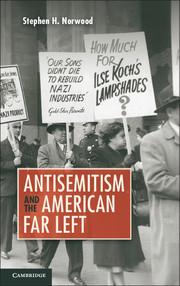Book contents
- Frontmatter
- Dedication
- Contents
- Photos
- 1 Promoting a Socialism of Fools
- 2 American Communists’ Tangled Responses to Antisemitism and Nazism, 1920–1939
- 3 World War II
- 4 Abandoning Assimilation
- 5 “Two, Four, Six, Eight, We Demand a Jewish State”
- 6 “Fiends in Human Form”
- 7 The Jewish Question Discarded
- 8 Shaping the Next Generations
- Notes
- Bibliography
- Index
5 - “Two, Four, Six, Eight, We Demand a Jewish State”
Communist Support for Partition and the Jewish War of Liberation, 1947–1948
Published online by Cambridge University Press: 05 June 2014
- Frontmatter
- Dedication
- Contents
- Photos
- 1 Promoting a Socialism of Fools
- 2 American Communists’ Tangled Responses to Antisemitism and Nazism, 1920–1939
- 3 World War II
- 4 Abandoning Assimilation
- 5 “Two, Four, Six, Eight, We Demand a Jewish State”
- 6 “Fiends in Human Form”
- 7 The Jewish Question Discarded
- 8 Shaping the Next Generations
- Notes
- Bibliography
- Index
Summary
Following a sharp shift in Soviet policy, the American CP in May 1947 abandoned its decades-long opposition to creating a Jewish state in Palestine and threw its support behind partitioning Palestine into two states, one Jewish and the other Arab. In Israel’s 1948 War of Independence, the CP and Communist-led trade unions enthusiastically supported the Israeli military effort to repel the invading Arab armies. The abrupt policy reversal occurred largely because the Kremlin believed that the Zionists’ struggle to dislodge the British in Palestine and create a Jewish state would hasten the collapse of the British Empire and allow the Soviets to gain a foothold in the Middle East.
Adhering to the Soviet line, the American CP from 1945 to May 1947 favored making Palestine a homeland for Jews but did not officially call for establishing a Jewish state there. Like the Soviets, it advocated a binational state in which Jewish minority rights would be guaranteed. On several occasions during this period, however, the Daily Worker gave tacit support to creating a Jewish state. The CP called on the United States and Britain to allow Jews in displaced persons camps in their occupation zones in Germany to immigrate to Palestine. It viewed Palestine not just as a refuge for part of the remnant of European Jewry annihilated in the Holocaust. The CP also urged a “planned and organized immigration into Palestine of the hundreds of thousands of Jews now living in the Orient,” the Arab and Islamic lands of the Middle East and North Africa.
- Type
- Chapter
- Information
- Antisemitism and the American Far Left , pp. 116 - 145Publisher: Cambridge University PressPrint publication year: 2013



